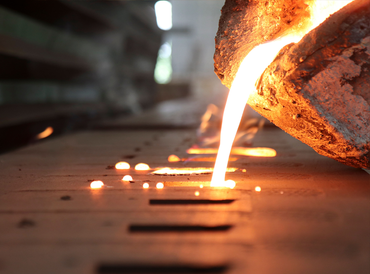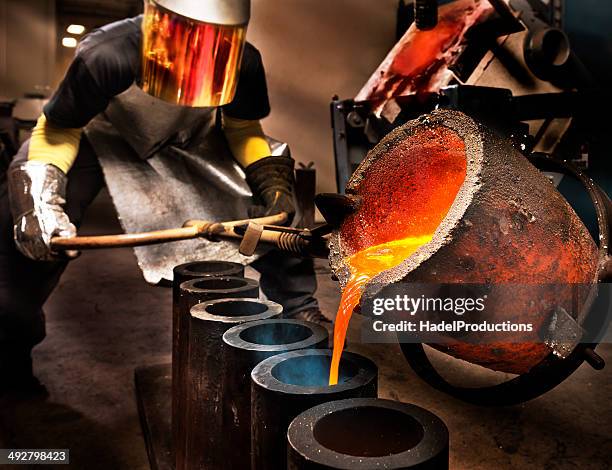Time-Tested Metal Casting Techniques That Still Inspire Modern Foundries
Wiki Article
Exploring the Art of Metal Casting: Strategies and Applications in Modern Foundries
Metal casting is a time-honored craft that integrates creativity with design precision. From old techniques to contemporary improvements, this process has progressed substantially. Various techniques, such as sand casting and lost-wax casting, display the adaptability of the tool. On the other hand, technologies like 3D printing are reshaping just how shops run. As the lines in between functionality and creativity blur, one should consider just how these advancements effect both conventional practices and modern applications. What lies ahead in this evolving landscape?The Principles of Metal Casting
Metal casting, a crucial process in production, includes pouring molten steel right into a mold and mildew to attain a preferred shape. This technique functions as a foundation in the production of complex metal elements throughout numerous industries. Crucial element of steel casting include the selection of products, which can vary from aluminum to steel, each selected for its certain buildings and application suitability. The procedure begins with mold and mildew production, which can be made from sand, metal, or ceramics, relying on the casting approach utilized. The molten metal is then thoroughly poured right into the mold and mildew, where it strengthens and cools. Crucial aspects such as temperature control, cooling down price, and mold and mildew design significantly impact the end product's quality and attributes. In enhancement, comprehending the physical and chemical buildings of the steel help in enhancing casting efficiency, eventually enhancing the effectiveness of the manufacturing procedure and making sure premium output customized to particular needs.Typical Casting Techniques
Traditional casting methods incorporate a range of methods that have actually stood the examination of time, showing their effectiveness in generating elaborate metal components. One famous technique is sand casting, which employs a blend of sand and a bonding agent to produce molds. The flexibility of sand casting allows for the production of varied shapes, making it appropriate for both small-scale and large manufacturing. Another remarkable technique is investment casting, commonly used for exact and complicated geometries. This method involves creating a wax pattern that is coated in a ceramic shell, which is after that warmed to eliminate the wax, leaving a dental caries for liquified steel. Additionally, pass away casting is made use of for high-volume manufacturing, where molten metal is injected right into multiple-use metal mold and mildews. Each of these traditional strategies stays relevant, showcasing the workmanship and ability integral in the art of metal casting, while satisfying the needs of various markets.Modern Innovations in Metal Casting
As industries progress, developments in metal casting are improving manufacturing processes and boosting effectiveness. Advanced modern technologies such as 3D printing and computer-aided style (CAD) are revolutionizing mold and mildew development, allowing for elaborate designs that were formerly unattainable. These techniques help with fast prototyping, minimizing lead times and cultivating creative thinking in item advancement.In addition, the integration of automation and robotics in foundries is improving procedures, minimizing human mistake, and enhancing safety. Smart sensors and real-time tracking systems allow accurate control of temperature level and product residential or commercial properties, making certain higher top quality outcomes.
Lasting methods are emerging, with the see this website usage of recycled products and energy-efficient heaters, lowering environmental impact. The fostering of sophisticated alloys and composite products is likewise increasing the possibilities of steel casting, resulting in stronger and lighter components. Overall, these contemporary advancements are transforming metal casting into a much more reliable, precise, and environmentally liable industry.
Applications Across Numerous Industries

While diverse sectors progressively rely on metal casting, the technique's adaptability plays a crucial function in meeting certain application needs. In the vehicle industry, metal casting is important for creating engine components, transmission real estates, and other complex components that call for precision and resilience. The aerospace market gain from lightweight casted components, making sure both performance and fuel efficiency. Additionally, the construction industry makes use of metal casting for architectural components, such as light beams and supports, boosting the integrity of bridges and structures.
The energy industry utilizes metal casting for generator blades and various other considerable machinery that should stand up to extreme problems. Clinical tools also see applications of steel casting, specifically in medical tools and prosthetics, where accuracy is critical - Metal Foundry. In general, the convenience and dependability of steel casting make it indispensable across different fields, adding to the improvement of modern technology and framework in contemporary society
The Artistic Side of Metal Casting
Typically associated with industrial applications, metal casting likewise locates its place in the domain name of art, where competent craftsmens change molten metal right into intricate designs and meaningful sculptures. This creative side of metal casting encompasses diverse methods, including sand casting, lost-wax casting, and financial investment casting, each offering one-of-a-kind possibilities for imagination. Artists utilize these techniques to produce works that vary from abstract kinds to natural depictions, enabling individual expression and commentary on modern problems.
Regularly Asked Inquiries
What Safety And Security Measures Are Necessary in a Metal Casting Factory?
Essential precaution in a steel casting foundry include personal safety tools, appropriate ventilation, emergency situation procedures, training in dealing with liquified metals, regular devices maintenance, and clear communication of hazards to ensure employee security and health and wellness. Metal Foundry.Exactly How Do Ecological Rules Effect Metal Casting Processes?
Ecological policies substantially influence steel casting processes by mandating the usage of cleaner innovations, minimizing exhausts, and advertising waste management techniques. Compliance often requires financial investments in tools, training, and alterations to existing treatments to decrease ecological influence.What Are the Usual Defects in Metal Spreadings?
Common defects in metal castings include porosity, shrinkage, incorporations, and misruns. These concerns can occur from incorrect mold layout, inadequate temperature image source level control, or contamination, eventually impacting the structural stability and general quality of the last item.Just How Is Waste Managed Throughout Metal Casting Manufacturing?
Waste monitoring in metal casting manufacturing entails recycling scrap steel, carrying out efficient material usage, and utilizing innovative innovations to lessen waste. Foundries take on practices like sand reclamation and appropriate disposal methods to minimize environmental effect.What Career Opportunities Exist in the Metal Casting Sector?
The steel casting sector uses varied profession opportunities, basics consisting of roles such as factory manager, metallurgical engineer, quality assurance inspector, pattern manufacturer, and production manager, providing to different ability and expertise in making processes.Metal casting, a pivotal process in manufacturing, involves putting liquified steel right into a mold and mildew to achieve a wanted shape. Furthermore, die casting is made use of for high-volume production, where liquified metal is infused right into recyclable steel mold and mildews. While varied sectors significantly count on metal casting, the strategy's flexibility plays a vital function in meeting certain application demands. Usually connected with commercial applications, steel casting also finds its location in the domain name of art, where skilled artisans transform molten metal into intricate designs and expressive sculptures. Waste management in steel casting production entails recycling scrap steel, applying efficient material usage, and utilizing sophisticated technologies to reduce waste.
Report this wiki page